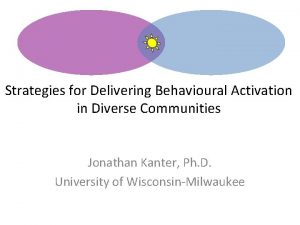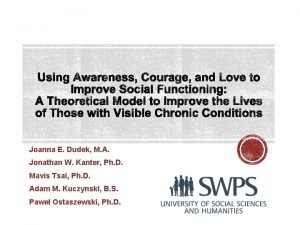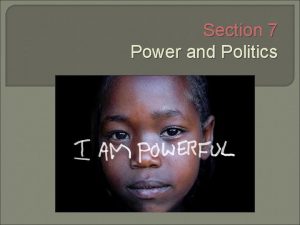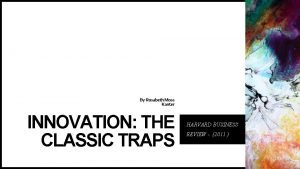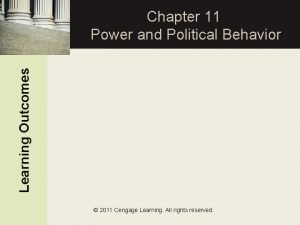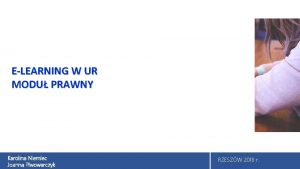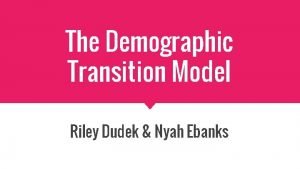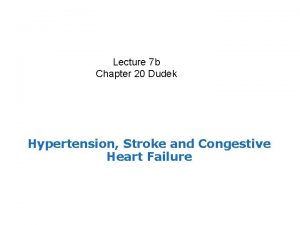Joanna E Dudek M A Jonathan W Kanter

























- Slides: 25

Joanna E. Dudek, M. A. Jonathan W. Kanter, Ph. D. Mavis Tsai, Ph. D. Adam M. Kuczynski, B. S. Paweł Ostaszewski, Ph. D.


§ “…any condition altering individual appearance in a way that is different from the perceived norm” § These differences can be: § Congenital § Acquired (e. g. , chronic illness, accident, surgery) Lipedema Cleft palate Psoriasis Acne Burns Bessell, A. , Dures, E. , Semple, C. , & Jackson, S. (2012). Addressing appearance-related distress across clinical conditions. British Journal of Nursing, 21(19), 1138– 1143.

Stigmatization § Sociocultural norms define ‘acceptable’ appearance § Evolutionary psychology: attractiveness is important in choosing potential partner § The more visible and aesthetically displeasing the condition, the greater risk of stigmatization Staring Devaluation Humiliation Unsolicited Aggression Disgust questioning Discrimination Name calling Rejection Gilbert, P. , & Miles, J. (Eds. ). (2002). Body Shame: Conceptualisation, Research and Treatment. Hove, East Sussex: Routledge.

Don’t Look Down on Me Video https: //www. youtube. com/watch? v=m. D_PWU 6 K 514

…men and young men or teenage “Dating was almost I don't feel sexually attractive. I have boys run up to me and insult my impossible as was close a hard time believing my spouse appearance. I've been called Shamu friendships with other girls truly wishes to engage me in true the Whale. I've been encircled by a I also do not wish to go out who didn't want to ruin their intimacy. I have to ward off awful group of males while walking and because of my past own chances of dating. ” thoughts of just being a receptacle. laughed at…It seems I can never go experiences with nasty people. My spouse has never treated me in out anywhere, even to my medical I'm very tired of the public this way, but it is my own idea of appointments without having an humiliation because of what myself. incident. my body looks like. …when I'm out strangers tend now have lovely young to. With the surge of smartphones, I avoid me. They will sit on a men snapping my photo or recording me sometimes. I different bench. They will wait for have no idea why, but they are sometimes caught taking the next elevator. They avoid my picture. It feels like a complete violation…. making contact with me at all costs if possible, and certainly not touching. ”


50 Loneliness/no social connection Social connection is fundamental to 50 health, well-being, and longevity 30 and is identified as one of the most 20 important public health problems in the 5 world. Excessive Smoking Excessive Drinking Obesity Air Pollution 0 10 20 30 40 50 Holt-Lunstad J, Smith TB, Layton JB (2010) Social Relationships and Mortality Risk: A Meta-analytic Review. PLo. S Med 7(7): e 1000316. doi: 10. 1371/journal. pmed. 1000316 60

FAP maximizes the natural functional mechanisms of social connection in psychotherapy


Awareness • Your present-moment self (your body, thoughts, feelings) • Your values, needs, goals, identity • The other: empathy • Your impact on the other person Courage • Acceptance, providing safety & reciprocal vulnerability • Expressing understanding, empathy, and validation • Giving others what they need (specific things) • Providing closeness and connection • Respecting boundaries • Providing support, promising • Providing feedback • Receiving difficult feedback Self-Love • Expressing appreciation Acceptance of yourself (awareness, self-compassion) Accepting caring and loving feelings from others Cultivating positive feelings in yourself (appreciations, pride) Self-care (activities that soothe, calm, rejuvenate, recharge, or bring pleasure) • Expressing vulnerability and emotion • Speaking your truth (speaking from the heart) • Asking for what you need • Closeness and Connection • Setting boundaries • Asking for support • Asking for difficult feedback • Giving difficult feedback • Asking for appreciation • • Love

Awareness • Paying attention only to some parts of experience (for example hyperfocused on their bodies or selfstigmatizing thougts or/and ignoring certain feelings, impact on others, during an interpersonal interaction) • Missing or misinterpret signals of attention and care

Awareness • Paying attention only to some parts of experience (for example hyperfocused on their bodies or selfstigmatizing thougts or/and ignoring certain feelings, impact on others, during an interpersonal interaction) Courage • Ignoring or misinterpret signals Avoiding • social interactions, intimacy, and of attention and care vulnerability due to fear of being hurt or rejected • Behaving in a submissive ways (e. g. not expressing needs, no boundaries setting in relationships (e. g. , to be accepted)

Awareness • Paying attention only to some parts of experience (for example hyperfocused on their bodies or selfstigmatizing thougts or/and ignoring certain feelings, impact on others, during an interpersonal interaction) Courage • • Love Ignoring or misinterpret signals of attention and care • Acting with hostility in order to protect Avoiding • social interactions, intimacy, and vulnerability due to fear of being hurt or themselves from being hurt rejected • Difficulties in responding with love to Behaving in a submissive ways (e. g. not problems of people who don’t have expressing needs, no boundaries setting similar experiences in relationships (e. g. , to be accepted)

Awareness • Paying attention only to some parts of experience (for example hyperfocused on their bodies or selfstigmatizing thougts or/and ignoring certain feelings, impact on others, during an interpersonal interaction) Love Courage • • Ignoring or misinterpret signals of attention and care • Acting with hostility in order to protect Avoiding • social interactions, intimacy, and vulnerability due to fear of being hurt or themselves from being hurt rejected • Difficulties in responding with love to Behaving in a submissive ways (e. g. not problems of people who don’t have expressing needs, no boundaries setting similar experiences in relationships (e. g. , to be accepted) Self-Love • They may disregard their own needs and have difficulties with receiving love and help from others.

Awareness • • • Noticing what is happening in their bodies - fear, disgust shame, and also love, curiosity, thoughts, inner sensations Recognizing their own needs and values, impact of their learning history Noticing and interpreting signals from other people (discriminating: signals of attention, care, interest; with whom they can take risks and self disclose, signals from others indicating that they are struggling too) • Noticing how they impact others

Awareness • • Noticing what is happening in their bodies - fear, disgust shame, and also love, curiosity, thoughts, inner sensations Recognizing their own needs and values, , impact of their learning history Courage • • Engaging in social interactions, • Noticing and interpreting signals from other people including new social interactions (discriminating: signals of attention, care, interest; with (expanding social network) whom they can take risks and self disclose, signals from others indicating that they are struggling too) Initiating conversations, asking • Noticing how they impact others questions that build closeness, selfdisclosing appropriately • Engaging in interactions involving vulnerability, closeness, and trust • Asking for what they need openly, tolerating conflicts, setting boundaries, and not engaging in violent relationships

Awareness • • • Noticing what is happening in their bodies - fear, disgust shame, and also love, curiosity, thoughts, inner sensations • Recognizing their own needs and values • Noticing and interpreting signals from other people Love Courage (discriminating: signals of attention, care, interest; with • self Giving positive feedback, giving Engaging in socialthey interactions, whom can take risks and disclose, signals including new interactions fromsocial others indicating that they appreciation are struggling too) • Acting with empathy and love towards (expanding social network) • Noticing how they impact others people even if they don’t share similar painful experiences Initiating conversations, asking questions that build closeness, self- • Being open to different interpretations of others’ reactions disclosing appropriately • Shaping others’ behaviors (i. e. , reinforcing desired pro-social Engaging in interactions involving responses in others); modeling vulnerability, closeness, and trust awareness, courage, and love; actively building a social support Asking for what they need openly, network tolerating conflicts, setting boundaries, and not engaging in violent relationships

Awareness • • • Noticing what is happening in their bodies - fear, disgust shame, and also love, curiosity, thoughts, inner sensations • Recognizing their own needs and values • Noticing and interpreting signals from other people Love Courage (discriminating: signals of attention, care, interest; with • Giving positive feedback, giving Engaging in socialthey interactions, whom can take risks and self disclose, signals appreciation including new interactions fromsocial others indicating that they are struggling too) • Acting with empathy and love towards (expanding social network) • Noticing how they impact others people even if they don’t share similar painful experiences Initiating conversations, asking questions that build closeness, self- • Being open to different interpretations of others’ reactions disclosing appropriately Self-Love • shaping others’ behaviors (i. e. , when lacking reinforcing desired pro-social Engaging in interactions involving • Self-appreciation reinforcement others, modeling self-pride responsesfrom in others); vulnerability, closeness, and trust • Receiving love and care from awareness, courage, andothers love; actively self-compassion, attending building a social support networkto Asking for what they need openly, • Showing own needs, self-care, body care (healthy tolerating conflicts, setting boundaries, habits) and not engaging in violent relationships

in-session behavioral indicators (CRBs)

CRB 2 s and generalizing these

Awareness Courage Love Self-Love

Title/reading/discussion A Your body is a brush that you paint your life with (reading before session) Mindful attention to the body, body related stories, shame Homework: ACL log C Sharing shameful memories, feelings, and moments of stigmatization about the body L SL Answering with What does my love, validation, body need to vulnerable be nurtured and sharing loved?

“A deep sense of love and belonging is an irreducible need of all people. We are biologically, cognitively, physically, and spiritually wired to love, to be loved, and to belong. When those needs are not met, we don't function as we were meant to. We break. We fall apart. We numb. We ache. We hurt others. We get sick. ”

joannaedudek@gmail. com
 Dudek joanna
Dudek joanna Jonathan kanter
Jonathan kanter Jonathan kanter wikipedia
Jonathan kanter wikipedia Rzeczpospolita trojga narodów mapa
Rzeczpospolita trojga narodów mapa Lilie albo kwiatki prohibicyjne
Lilie albo kwiatki prohibicyjne Jerzy dudek z bratem
Jerzy dudek z bratem Nancy dudek
Nancy dudek Andrzej kawalec
Andrzej kawalec Ido kanter
Ido kanter Liina kanter
Liina kanter Power and political behavior
Power and political behavior Kanter's symbols of power
Kanter's symbols of power Elisabeth moss kanter
Elisabeth moss kanter Kanter's symbols of powerlessness
Kanter's symbols of powerlessness Employee empowerment grid
Employee empowerment grid Kanter 10 commandments
Kanter 10 commandments Joanna niemiec ur
Joanna niemiec ur Joanna franklin
Joanna franklin Joanna dickens
Joanna dickens Joanna acocella
Joanna acocella Joanna liss
Joanna liss Zwyrodnienie barwnikowe siatkówki
Zwyrodnienie barwnikowe siatkówki Joanna zamojska
Joanna zamojska Joanna norton
Joanna norton Bike
Bike Joanna pieciukiewicz
Joanna pieciukiewicz

